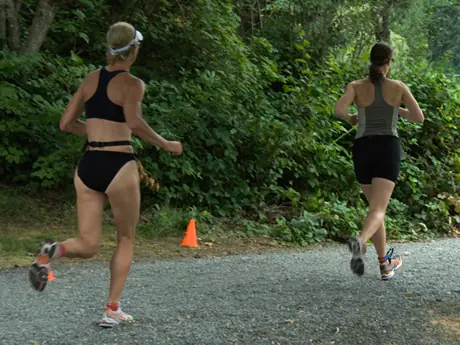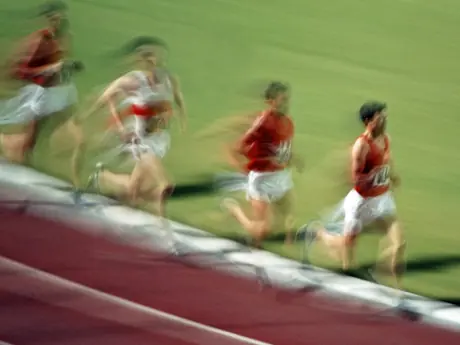So far, we have discussed two flexibilities that are critical to good running mechanics: soleus flexibility and hip flexor/upper quad flexibility. These are the very same areas that become very tight with frequent riding in the aero position. Therefore, it is with no surprise that we see so many poor running strides on the marathon course of any Ironman.
Hip Drop
This is best evaluated through video run analysis, and is presented by the dropping of one or both of the hips, upon foot strike and weight transfer.
More: 13 Rules for Marathon Training
Drawing a horizontal line across the very tops of the hip bones, a drop of more than 14 degrees can be indicative of weak gluteus media and/or TFLs (tensor fascia lata). A good video analysis will very easily identify too much hip drop and the effects that it has on your running stride.
From behind, this hip drop can be seen as a zig-zag pattern that starts at the feet, extending up through the hips, back and head. Upon the striking and dropping of the hip, we essentially see all of these body parts going in different lateral directions. The legs and hips end up leaning in different directions. The back follows the legs, and the head follows the hips. Hence, the zig-zag effect!
This is a major chain-reaction of lateral deflection being directed in opposing directions. For example, with a weak left gluteus medius the right hip drops and the left hip leans to the left, causing the legs and back to actually lean to the right. And, in a last ditch effort to keep the body from falling over, the head goes the way of the hip, leaning to the left. All of this, when our aim is to run neither left nor right, but forward!
This hip drop leads to unnecessary usage of muscle glycogen at a time when we are doing our best to preserve it. Furthermore, the hip drop also tends to contribute to a lower running cadence, because more time is spent in contact with the ground, upon foot strike and rebound. The more energy that can be put into moving forward, rather than left, right, up, or down, the faster you will be.
More: Push Your Anaerobic Threshold With PPTs
Lack of Shoulder Rotation
The shoulders play an integral role in efficient running posture. Many athletes are under the false impression that they should be running with a very square shoulder position. In fact, it is just the opposite as the best runners actually use their shoulder mass as a tool to help propel them forward, late in races when their lower bodies becomes extremely fatigued.
A lack of shoulder rotation tends to be cognitive in nature and/or related to a weakness in rotational core strength. A strong upper torso rotation, late in the run, requires a great deal of rotational core strength, as the athlete is relying solely on the soft-tissue strength of their core to facilitate the rotation.
Dropped Arm Position
Both dropped arm and "elbows out" positions are typically the result of hip weakness and/or cognitive habit. Typically, runners with weak hips on one or both sides tend to drop their arm on the side of the weak hip, in an effort to pull the body back over to that side. This is one of those inefficient compensatory motions that slow runners down. These arm positions tend to limit cadence as more rotational mass is presented in the form of arm mass further away from the shoulder.
More: How to Create Your Ironman Nutrition Plan
Most world-class runners exhibit the same acute elbow angle deep into their recovery posture, as they maintain during the drive portion of their arm swing. It is as if the elbow is being pulled directly back from its most forward position with a fishing line!
Compensation for any of the above identified deficiencies fall into two different categories, namely cognitive and muscular. Those cognitive in nature require the runner to make mental changes to their posture while running. The recommended muscular changes can be addressed in strength and flexibility conditioning.
Below, I focus on the best, most targeted, run-specific stretching and strengthening exercises to address the deficiencies identified above.
These exercises are those that I most commonly prescribe to athletes, following a detailed running mechanics assessment. Each of these directly impact one or more of the above critical areas, required for great running mechanics.
- 2
- of
- 3
About the Author

Get ACTIVE on the Go


Couch to 5K®
The best way to get new runners off the couch and across the finish line of their first 5K.
Available for iOS | Android








Discuss This Article